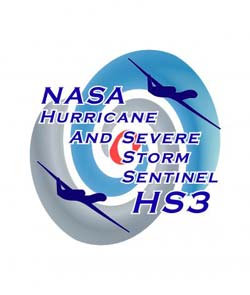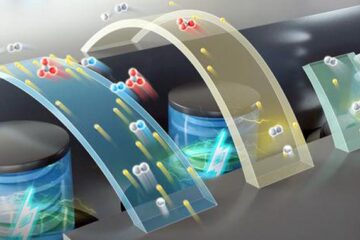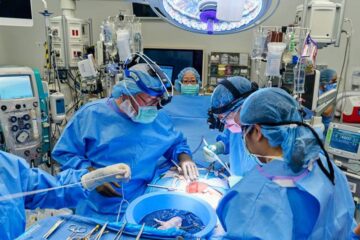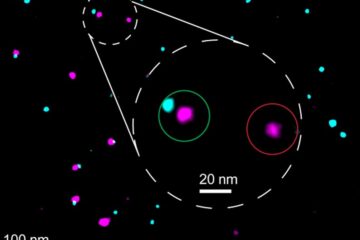NASA mission sending unmanned aircraft over hurricanes this year

The mission logo for the Hurricane and Severe Storm Sentinel (HS3) airborne mission. HS3 will investigate the processes that underlie hurricane formation and intensity change in the Atlantic Ocean basin. Credit: NASA<br>
Several NASA centers are joining federal and university partners in the Hurricane and Severe Storm Sentinel (HS3) airborne mission targeted to investigate the processes that underlie hurricane formation and intensity change in the Atlantic Ocean basin.
NASA's unmanned sentinels are autonomously flown. The NASA Global Hawk is well-suited for hurricane investigations because it can over-fly hurricanes at altitudes greater than 60,000 feet with flight durations of up to 28 hours – something piloted aircraft would find nearly impossible to do. Global Hawks were used in the agency's 2010 Genesis and Rapid Intensification Processes (GRIP) hurricane mission and the Global Hawk Pacific (GloPac) environmental science mission.
“Hurricane intensity can be very hard to predict because of an insufficient understanding of how clouds and wind patterns within a storm interact with the storm's environment. HS3 seeks to improve our understanding of these processes by taking advantage of the surveillance capabilities of the Global Hawk along with measurements from a suite of advanced instruments,” said Scott Braun, HS3 mission principal investigator and research meteorologist at NASA's Goddard Space Flight Center in Greenbelt, Md.
HS3 will use two Global Hawk aircraft and six different instruments this summer, flying from a base of operations at Wallops Flight Facility in Virginia.
“One aircraft will sample the environment of storms while the other will measure eyewall and rainband winds and precipitation,” Braun said. HS3 will examine the large-scale environment that tropical storms form in and move through and how that environment affects the inner workings of the storms.
HS3 will address the controversial role of the hot, dry, and dusty Saharan Air Layer in tropical storm formation and intensification. Past studies have suggested that the Saharan Air Layer can both favor or suppress intensification. In addition, HS3 will examine the extent to which deep convection in the inner-core region of storms is a key driver of intensity change or just a response to storms finding favorable sources of energy.
The HS3 mission will operate during portions of the Atlantic hurricane seasons, which run from June 1 to November 30. The 2012 mission will run from late August through early October.
The instruments to be mounted in the Global Hawk aircraft that will examine the environment of the storms include the scanning High-resolution Interferometer Sounder (S-HIS), the Advanced Vertical Atmospheric Profiling System (AVAPS) also known as dropsondes, and the Cloud Physics Lidar (CPL). The Tropospheric Wind Lidar Technology Experiment (TWiLiTE) Doppler wind lidar will likely fly in the 2013 mission.
Another set of instruments will fly on the Global Hawk focusing on the inner region of the storms. Those instruments include the High-Altitude Imaging Wind and Rain Airborne Profiler (HIWRAP) conically scanning Doppler radar, the Hurricane Imaging Radiometer (HIRAD) multi-frequency interferometric radiometer, and the High-Altitude Monolithic Microwave Integrated Circuit Sounding Radiometer (HAMSR) microwave sounder. Most of these instruments represent advanced technology developed by NASA, that in some cases are precursors to future satellite sensors.
NASA's Science Mission Directorate Global Hawk aircraft will deploy to Wallops Flight Facility from their home base at NASA's Dryden Flight Research Center on Edwards Air Force Base, Calif.
“HS3 marks the first time that NASA's Global Hawks will deploy away from Dryden for a mission, potentially marking the beginning of an era in which they are operated regularly from Wallops,” said Paul Newman, atmospheric scientist at NASA Goddard and deputy principal investigator on the HS3 mission.
NASA's Science Mission Directorate in Washington is establishing a Global Hawk operations center for science operations from Wallops.. “With the Global Hawks at NASA Dryden in California, NASA Wallops will become the 'Global Hawk – Eastern' science center,” Newman said.
From rockets studying the upper atmosphere to unmanned aircraft flying over hurricanes, NASA's Wallops Flight Facility is fast becoming a busy place for science. Wallops is one of several NASA centers involved with the HS3 mission. Others include Goddard, Dryden, Ames Research Center, Marshall Space Flight Center, and the Jet Propulsion Laboratory.
The HS3 mission is funded by NASA Headquarters and managed by NASA's Earth System Science Pathfinder Program at NASA's Langley Research Center, Hampton, Va. The HS3 mission also involves collaborations with various partners including the National Centers for Environmental Prediction, Naval Postgraduate School, Naval Research Laboratory, NOAA's Hurricane Research Division and Earth System Research Laboratory, Northrop Grumman Space Technology, National Center for Atmospheric Research, State University of New York at Albany, University of Maryland – Baltimore County, University of Wisconsin, and University of Utah.
Media Contact
More Information:
http://www.nasa.govAll latest news from the category: Earth Sciences
Earth Sciences (also referred to as Geosciences), which deals with basic issues surrounding our planet, plays a vital role in the area of energy and raw materials supply.
Earth Sciences comprises subjects such as geology, geography, geological informatics, paleontology, mineralogy, petrography, crystallography, geophysics, geodesy, glaciology, cartography, photogrammetry, meteorology and seismology, early-warning systems, earthquake research and polar research.
Newest articles

High-energy-density aqueous battery based on halogen multi-electron transfer
Traditional non-aqueous lithium-ion batteries have a high energy density, but their safety is compromised due to the flammable organic electrolytes they utilize. Aqueous batteries use water as the solvent for…

First-ever combined heart pump and pig kidney transplant
…gives new hope to patient with terminal illness. Surgeons at NYU Langone Health performed the first-ever combined mechanical heart pump and gene-edited pig kidney transplant surgery in a 54-year-old woman…

Biophysics: Testing how well biomarkers work
LMU researchers have developed a method to determine how reliably target proteins can be labeled using super-resolution fluorescence microscopy. Modern microscopy techniques make it possible to examine the inner workings…





















